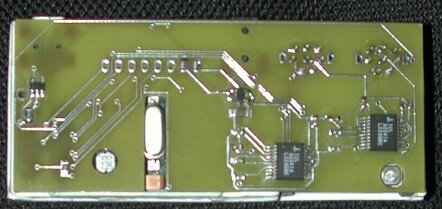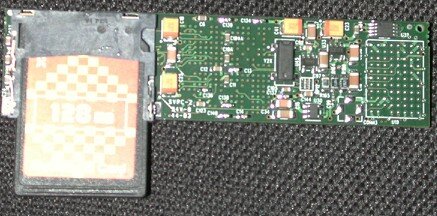My initial post on the Gumstix elicited the desired reaction: people gave me information! The way to get fast answers on the net isn't to ask a question, but to post information that isn't true.
My friend Adam Flaherty (major creator of the NoCat night light among other feats of techno-coolness) wanted to see the Gumstix. So we got together at Aroma Roasters and drank coffee while prying apart the case and unscrewing things with my Swiss Army knife. What we found, and a quick web search, reveals all sorts of fun potentials.
First a look at the hardware. Taking turns Adam and I were able to pry apart the plastic case. Sadly it was glued together, so it suffered under the onslaught of two caffeinated geeks bearing tools.

Depending on which half of the casing pops off first you will see the back of the daughter board. the silver can popping through the slot on the left side of the bottom is the crystal from the Gumstix. The two chips on the right are the transceivers for the two serial ports. The two clusters of solder blobs on the top right are the back sides of the serial connectors.

The Gumstix and the much larger daughter board are held together with one screw. Removing that with a pocket knife yielded several near misses, and the separation of Gumstix and daughter board. The front of the daughter board reveals the two serial ports (top left), the power connector (the rectangle next to them), the USB connector (top right) and the spring connector to the Gumstix.

Moving to the Gumstix itself we have the MMC memory socket, shown here with a 128 mb MMC card, and some electronics.

Flipping over the Gumstix shows a bunch of interesting chips, and on the far right, the pads that connect to the mother board (or to other devices of your own creation. Cue scary music and maniacal laughter...).
The description of the 'bare-pad' connector is available on the Gumstix site. To me the interesting thing is that we appear to have access to the I2C bus. This is a 2 wire bus designed to connect CPU's and microcontrollers (yes, I know that those are the same except for size...) with various devices, such as LCD displays. Take a look at the connector spec and let me know what I'm missing!
I have more to write about the Gumstix hardware and software tool chain, but I'll save that for another day. And now, hopefully I'll be able to put it all back together, otherwise I suppose my Gumstix will become a paper cut on the bleeding edge!
Rich Gibson is a Perl/Database programmer whose current fascination is creating tools to aid in the acquistion, management, and presentation of information with a geographic component.
Posted by nym at March 10, 2004 10:59 PM | TrackBack